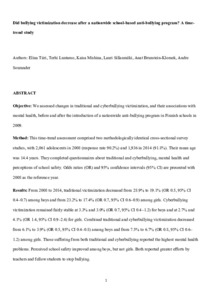Did Bullying Victimization Decrease After Nationwide School-Based Antibullying Program? A Time-Trend Study
Elina Tiiri; Terhi Luntamo; Kaisa Mishina; Lauri Sillanmäki; Anat Brunstein Klomek; Andre Sourander
https://urn.fi/URN:NBN:fi-fe2021042824445
Tiivistelmä
Objective
We assessed changes in traditional and cyberbullying victimization, and their associations with mental health, before and after the introduction of a nationwide antibullying program in Finnish schools in 2009.
Method
This time-trend assessment comprised two methodologically identical cross-sectional survey studies, with 2,061 adolescents in 2008 (response rate 90.2%) and 1,936 in 2014 (91.8%). Their mean age was 14.4 years. They completed questionnaires about traditional and cyberbullying, mental health, and perceptions of school safety. Odds ratios (OR) and 95% confidence intervals are presented with 2008 as the reference year.
Results
From 2008 to 2014, traditional victimization decreased from 28.9% to 19.1% (odds ratio [OR] = 0.5, 95% CI = 0.4–0.7) among boys and from 23.2% to 17.4% (OR = 0.7, 95% CI = 0.6–0.9) among girls. Cyberbullying victimization remained fairly stable at 3.3% and 3.0% (OR = 0.7, 95% CI = 0.4–1.2) for boys and at 2.7% and 4.1% (OR = 1.4, 95% CI = 0.9–2.4) for girls. Combined traditional and cyberbullying victimization decreased from 6.1% to 3.9% (OR = 0.5, 95% CI = 0.4–0.8) among boys and from 7.5% to 6.7% (OR = 0.8, 95% CI = 0.6–1.2) among girls. Those experiencing both traditional and cyberbullying reported the highest mental health problems. Perceived school safety improved among boys, but not among girls. Both boys and girls reported greater efforts by teachers and fellow students to stop bullying.
Conclusion
Combined traditional and cyberbullying victimization was an indicator of comorbid mental health problems. Interventions that target both types of bullying, and that are integrated with mental health promotion, are needed.
Kokoelmat
- Rinnakkaistallenteet [27094]
